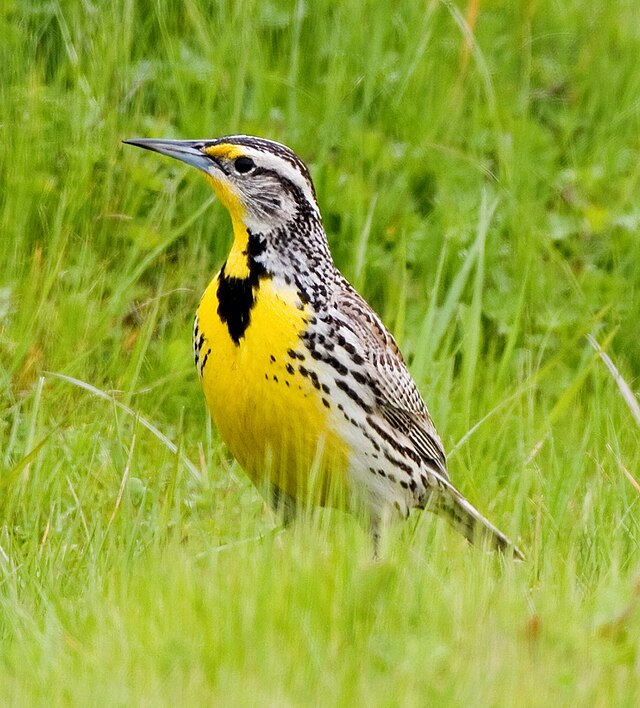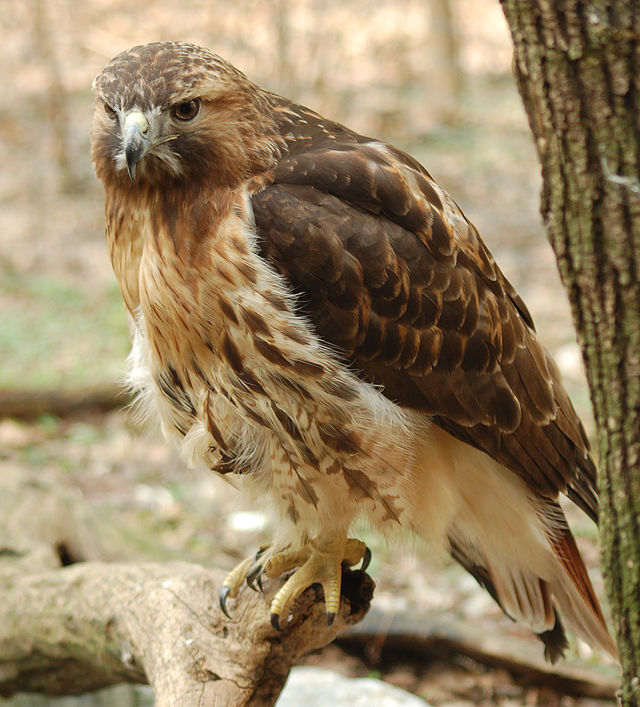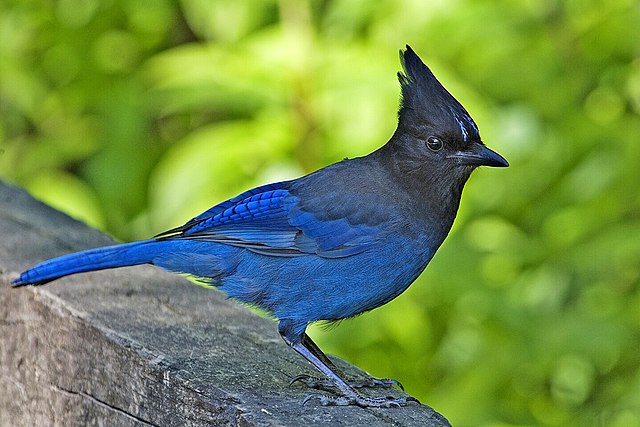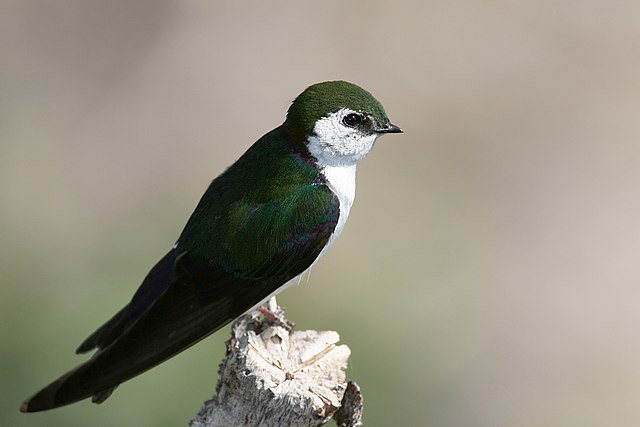Loading AI tools
From Wikipedia, the free encyclopedia
This list of birds of Wyoming includes species documented in the U.S. state of Wyoming by the Wyoming Game and Fish Department (WGFD) as of May 2021 with some additions from Avibase.[1] The list contains 452 species. Of them, 118 are classed as accidental, and seven species have been introduced to North America. An additional accidental species has been added from another source.

This list is presented in the taxonomic sequence of the Check-list of North and Middle American Birds, 7th edition through the 62nd Supplement, published by the American Ornithological Society (AOS).[2] Common and scientific names are also those of the Check-list, except that the common names of families are from the Clements taxonomy because the AOS list does not include them.
Unless otherwise noted, all species listed below are considered to occur regularly in Wyoming as permanent residents, summer or winter visitors, or migrants. These tags are used to annotate some species:


Order: Anseriformes Family: Anatidae
The family Anatidae includes the ducks and most duck-like waterfowl, such as geese and swans. These birds are adapted to an aquatic existence with webbed feet, bills which are flattened to a greater or lesser extent, and feathers that are excellent at shedding water due to special oils. Forty-one species have been recorded in Wyoming.
Order: Galliformes Family: Odontophoridae
The New World quails are small, plump terrestrial birds only distantly related to the quails of the Old World, but named for their similar appearance and habits. One species has been recorded in Wyoming.

Order: Galliformes Family: Phasianidae
Phasianidae consists of the pheasants and their allies. These are terrestrial species, variable in size but generally plump with broad relatively short wings. Many species are gamebirds or have been domesticated as a food source for humans. Ten species have been recorded in Wyoming.

Order: Podicipediformes Family: Podicipedidae
Grebes are small to medium-large freshwater diving birds. They have lobed toes and are excellent swimmers and divers. However, they have their feet placed far back on the body, making them quite ungainly on land. Six species have been recorded in Wyoming.

Order: Columbiformes Family: Columbidae
Pigeons and doves are stout-bodied birds with short necks and short slender bills with a fleshy cere. Five species have been recorded in Wyoming.
Order: Cuculiformes Family: Cuculidae
The family Cuculidae includes cuckoos, roadrunners, and anis. These birds are of variable size with slender bodies, long tails, and strong legs. Two species have been recorded in Wyoming.
Order: Caprimulgiformes Family: Caprimulgidae
Nightjars are medium-sized nocturnal birds that usually nest on the ground. They have long wings, short legs, and very short bills. Most have small feet, of little use for walking, and long pointed wings. Their soft plumage is cryptically colored to resemble bark or leaves. Three species have been recorded in Wyoming.
Order: Apodiformes Family: Apodidae
The swifts are small birds which spend the majority of their lives flying. These birds have very short legs and never settle voluntarily on the ground, perching instead only on vertical surfaces. Many swifts have very long, swept-back wings which resemble a crescent or boomerang. Four species have been recorded in Wyoming.
Order: Apodiformes Family: Trochilidae
Hummingbirds are small birds capable of hovering in mid-air due to the rapid flapping of their wings. They are the only birds that can fly backwards. Seven species have been recorded in Wyoming.

Order: Gruiformes Family: Rallidae
Rallidae is a large family of small to medium-sized birds which includes the rails, crakes, coots, and gallinules. The most typical family members occupy dense vegetation in damp environments near lakes, swamps, or rivers. In general they are shy and secretive birds, making them difficult to observe. Most species have strong legs and long toes which are well adapted to soft uneven surfaces. They tend to have short, rounded wings and tend to be weak fliers. Seven species have been recorded in Wyoming.
Order: Gruiformes Family: Gruidae
Cranes are large, long-legged, and long-necked birds. Unlike the similar-looking but unrelated herons, cranes fly with necks outstretched, not pulled back. Most have elaborate and noisy courting displays or "dances". Two species have been recorded in Wyoming.

Order: Charadriiformes Family: Recurvirostridae
Recurvirostridae is a family of large wading birds which includes the avocets and stilts. The avocets have long legs and long up-curved bills. The stilts have extremely long legs and long, thin, straight bills. Two species have been recorded in Wyoming.

Order: Charadriiformes Family: Charadriidae
The family Charadriidae includes the plovers, dotterels, and lapwings. They are small to medium-sized birds with compact bodies, short thick necks, and long, usually pointed, wings. They are found in open country worldwide, mostly in habitats near water. Seven species have been recorded in Wyoming.
Order: Charadriiformes Family: Scolopacidae
Scolopacidae is a large diverse family of small to medium-sized shorebirds including the sandpipers, curlews, godwits, shanks, tattlers, woodcocks, snipes, dowitchers, and phalaropes. The majority of these species eat small invertebrates picked out of the mud or soil. Different lengths of legs and bills enable multiple species to feed in the same habitat, particularly on the coast, without direct competition for food. Twenty-nine species have been recorded in Wyoming.
Order: Charadriiformes Family: Stercorariidae
Skuas and jaegers are in general medium to large birds, typically with gray or brown plumage, often with white markings on the wings. They have longish bills with hooked tips and webbed feet with sharp claws. They look like large dark gulls, but have a fleshy cere above the upper mandible. They are strong, acrobatic fliers. Three species have been recorded in Wyoming.
Order: Charadriiformes Family: Alcidae
The family Alcidae includes auks, murres, and puffins. These are short-winged birds that live on the open sea and normally only come ashore for breeding. Two species have been recorded in Wyoming.

Order: Charadriiformes Family: Laridae
Laridae is a family of medium to large seabirds and includes gulls, terns, kittiwakes, and skimmers. They are typically gray or white, often with black markings on the head or wings. They have stout, longish bills and webbed feet. Twenty-two species have been recorded in Wyoming.
Order: Gaviiformes Family: Gaviidae
Loons are aquatic birds the size of a large duck, to which they are unrelated. Their plumage is largely gray or black, and they have spear-shaped bills. Loons swim well and fly adequately, but are almost hopeless on land, because their legs are placed towards the rear of the body. Four species have been recorded in Wyoming.
Order: Procellariiformes Family: Procellariidae
The procellariids are the main group of medium-sized "true petrels", characterized by united nostrils with medium septum and a long outer functional primary.
Order: Ciconiiformes Family: Ciconiidae
Storks are large, heavy, long-legged, long-necked wading birds with long stout bills and wide wingspans. They lack the powder down that other wading birds such as herons, spoonbills, and ibises use to clean off fish slime. Storks lack a pharynx and are mute. One species has been recorded in Wyoming.
Order: Suliformes Family: Fregatidae
Frigatebirds are large seabirds usually found over tropical oceans. They are large, black, or black-and-white, with long wings and deeply forked tails. The males have colored inflatable throat pouches. They do not swim or walk and cannot take off from a flat surface. Having the largest wingspan-to-body-weight ratio of any bird, they are essentially aerial, able to stay aloft for more than a week. One species has been recorded in Wyoming.
Order: Suliformes Family: Phalacrocoracidae
Cormorants are medium-to-large aquatic birds, usually with mainly dark plumage and areas of colored skin on the face. The bill is long, thin, and sharply hooked. Their feet are four-toed and webbed. One species has been recorded in Wyoming.

Order: Pelecaniformes Family: Pelecanidae
Pelicans are very large water birds with a distinctive pouch under their beak. Like other birds in the order Pelecaniformes, they have four webbed toes. Two species have been recorded in Wyoming.

Order: Pelecaniformes Family: Ardeidae
The family Ardeidae contains the herons, egrets, and bitterns. Herons and egrets are medium to large wading birds with long necks and legs. Bitterns tend to be shorter necked and more secretive. Members of Ardeidae fly with their necks retracted, unlike other long-necked birds such as storks, ibises, and spoonbills. Eleven species have been recorded in Wyoming.
Order: Pelecaniformes Family: Threskiornithidae
The family Threskiornithidae includes the ibises and spoonbills. They have long, broad wings. Their bodies tend to be elongated, the neck more so, with rather long legs. The bill is also long, decurved in the case of the ibises, straight and distinctively flattened in the spoonbills. Three species have been recorded in Wyoming.

Order: Cathartiformes Family: Cathartidae
The New World vultures are not closely related to Old World vultures, but superficially resemble them because of convergent evolution. Like the Old World vultures, they are scavengers, however, unlike Old World vultures, which find carcasses by sight, New World vultures have a good sense of smell with which they locate carcasses. Three species have been recorded in Wyoming.
Order: Accipitriformes Family: Pandionidae
Pandionidae is a family of fish-eating birds of prey possessing a very large, powerful hooked beak for tearing flesh from their prey, strong legs, powerful talons, and keen eyesight. The family is monotypic.

Order: Accipitriformes Family: Accipitridae
Accipitridae is a family of birds of prey which includes hawks, eagles, kites, harriers, and Old World vultures. These birds have very large powerful hooked beaks for tearing flesh from their prey, strong legs, powerful talons, and keen eyesight. Sixteen species have been recorded in Wyoming.
Order: Strigiformes Family: Tytonidae
Barn-owls are medium to large owls with large heads and characteristic heart-shaped faces. They have long strong legs with powerful talons. One species has been recorded in Wyoming.

Order: Strigiformes Family: Strigidae
Typical owls are small to large solitary nocturnal birds of prey. They have large forward-facing eyes and ears, a hawk-like beak, and a conspicuous circle of feathers around each eye called a facial disk. Fourteen species have been recorded in Wyoming.
Order: Coraciiformes Family: Alcedinidae
Kingfishers are medium-sized birds with large heads, long pointed bills, short legs, and stubby tails. One species has been recorded in Wyoming.
Order: Piciformes Family: Picidae
Woodpeckers are small to medium-sized birds with chisel-like beaks, short legs, stiff tails, and long tongues used for capturing insects. Some species have feet with two toes pointing forward and two backward, while several species have only three toes. Many woodpeckers have the habit of tapping noisily on tree trunks with their beaks. Fourteen species have been recorded in Wyoming.

Order: Falconiformes Family: Falconidae
Falconidae is a family of diurnal birds of prey, notably the falcons and caracaras. They differ from hawks, eagles, and kites in that they kill with their beaks instead of their talons. Six species have been recorded in Wyoming.
Order: Passeriformes Family: Tyrannidae
Tyrant flycatchers are Passerine birds which occur throughout North and South America. They superficially resemble the Old World flycatchers, but are more robust and have stronger bills. They do not have the sophisticated vocal capabilities of the songbirds. Most, but not all, are rather plain. As the name implies, most are insectivorous. Twenty-one species have been recorded in Wyoming.
Order: Passeriformes Family: Vireonidae
The vireos are a group of small to medium-sized passerine birds. They are typically greenish in color and resemble wood warblers apart from their heavier bills. Nine species have been recorded in Wyoming.

Order: Passeriformes Family: Laniidae
Shrikes are passerine birds known for their habit of catching other birds and small animals and impaling the uneaten portions of their bodies on thorns. A shrike's beak is hooked, like that of a typical bird of prey. Two species have been recorded in Wyoming.

Order: Passeriformes Family: Corvidae
The family Corvidae includes crows, ravens, jays, choughs, magpies, treepies, nutcrackers, and ground jays. Corvids are above average in size among the Passeriformes, and some of the larger species show high levels of intelligence. Nine species have been recorded in Wyoming.
Order: Passeriformes Family: Paridae
The Paridae are mainly small stocky woodland species with short stout bills. Some have crests. They are adaptable birds, with a mixed diet including seeds and insects. Three species have been recorded in Wyoming.
Order: Passeriformes Family: Alaudidae
Larks are small terrestrial birds with often extravagant songs and display flights. Most larks are fairly dull in appearance. Their food is insects and seeds. One species has been recorded in Wyoming.

Order: Passeriformes Family: Hirundinidae
The family Hirundinidae is adapted to aerial feeding. They have a slender streamlined body, long pointed wings, and a short bill with a wide gape. The feet are adapted to perching rather than walking, and the front toes are partially joined at the base. Seven species have been recorded in Wyoming.
Order: Passeriformes Family: Aegithalidae
Long-tailed tits are a group of small passerine birds with medium to long tails. They make woven bag nests in trees. Most eat a mixed diet which includes insects. One species has been recorded in Wyoming.

Order: Passeriformes Family: Regulidae
The kinglets are a small family of birds which resemble the titmice. They are very small insectivorous birds. The adults have colored crowns, giving rise to their names. Two species have been recorded in Wyoming.
Order: Passeriformes Family: Bombycillidae
The waxwings are a group of passerine birds with soft silky plumage and unique red tips to some of the wing feathers. In the Bohemian and cedar waxwings, these tips look like sealing wax and give the group its name. These are arboreal birds of northern forests. They live on insects in summer and berries in winter. Two species have been recorded in Wyoming.

Order: Passeriformes Family: Sittidae
Nuthatches are small woodland birds. They have the unusual ability to climb down trees head first, unlike other birds which can only go upwards. Nuthatches have big heads, short tails, and powerful bills and feet. Three species have been recorded in Wyoming.
Order: Passeriformes Family: Certhiidae
Treecreepers are small woodland birds, brown above and white below. They have thin pointed down-curved bills, which they use to extricate insects from bark. They have stiff tail feathers, like woodpeckers, which they use to support themselves on vertical trees. One species has been recorded in Wyoming.
Order: Passeriformes Family: Polioptilidae
These dainty birds resemble Old World warblers in their structure and habits, moving restlessly through the foliage seeking insects. The gnatcatchers are mainly soft bluish gray in color and have the typical insectivore's long sharp bill. Many species have distinctive black head patterns (especially males) and long, regularly cocked, black-and-white tails. One species has been recorded in Wyoming.
Order: Passeriformes Family: Troglodytidae
Wrens are small and inconspicuous birds, except for their loud songs. They have short wings and thin down-turned bills. Several species often hold their tails upright. All are insectivorous. Nine species have been recorded in Wyoming.

Order: Passeriformes Family: Mimidae
The mimids are a family of passerine birds which includes thrashers, mockingbirds, tremblers, and the New World catbirds. These birds are notable for their vocalization, especially their remarkable ability to mimic a wide variety of birds and other sounds heard outdoors. The species tend towards dull grays and browns in their appearance. Five species have been recorded in Wyoming.
Order: Passeriformes Family: Sturnidae
Starlings are small to medium-sized passerine birds. They are medium-sized passerines with strong feet. Their flight is strong and direct and they are very gregarious. Their preferred habitat is fairly open country, and they eat insects and fruit. Plumage is typically dark with a metallic sheen. One species has been recorded in Wyoming.
Order: Passeriformes Family: Cinclidae
Dippers are small, stout, birds that feed in cold, fast moving streams. One species has been recorded in Wyoming.

Order: Passeriformes Family: Turdidae
The thrushes are a group of passerine birds that occur mainly but not exclusively in the Old World. They are plump, soft plumaged, small to medium-sized insectivores or sometimes omnivores, often feeding on the ground. Many have attractive songs. Eleven species have been recorded in Wyoming.
Order: Passeriformes Family: Muscicapidae
The Old World flycatchers are a large family of small passerine birds mostly restricted to the Old World. These are mainly small arboreal insectivores, many of which, as the name implies, take their prey on the wing. One species has been recorded in Wyoming.

Order: Passeriformes Family: Passeridae
Old World sparrows are small passerine birds. In general, sparrows tend to be small plump brownish or grayish birds with short tails and short powerful beaks. Sparrows are seed eaters, but they also consume small insects. One species has been recorded in Wyoming.
Order: Passeriformes Family: Motacillidae
Motacillidae is a family of small passerine birds with medium to long tails. They include the wagtails, longclaws, and pipits. They are slender ground-feeding insectivores of open country. Two species have been recorded in Wyoming.
Order: Passeriformes Family: Fringillidae
Finches are seed-eating passerine birds, that are small to moderately large and have a strong beak, usually conical and in some species very large. All have twelve tail feathers and nine primaries. These birds have a bouncing flight with alternating bouts of flapping and gliding on closed wings, and most sing well. Seventeen species have been recorded in Wyoming.
Order: Passeriformes Family: Calcariidae
The Calcariidae are a group of passerine birds that were traditionally grouped with the New World sparrows, but differ in a number of respects and are usually found in open grassy areas. Five species have been recorded in Wyoming.

Order: Passeriformes Family: Passerellidae
Until 2017, these species were considered part of the family Emberizidae. Most of the species are known as sparrows, but these birds are not closely related to the Old World sparrows which are in the family Passeridae. Many of these have distinctive head patterns. Twenty-nine species have been recorded in Wyoming.
Order: Passeriformes Family: Icteriidae
This species was historically placed in the wood-warblers (Parulidae) but nonetheless most authorities were unsure if it belonged there. It was placed in its own family in 2017.
Order: Passeriformes Family: Icteridae
The icterids are a group of small to medium-sized, often colorful passerine birds restricted to the New World and include the grackles, New World blackbirds, and New World orioles. Most species have black as a predominant plumage color, often enlivened by yellow, orange, or red. Thirteen species have been recorded in Wyoming.

Order: Passeriformes Family: Parulidae
The wood-warblers are a group of small often colorful passerine birds restricted to the New World. Most are arboreal, but some like the ovenbird and the two waterthrushes, are more terrestrial. Most members of this family are insectivores. Thirty-nine species have been recorded in Wyoming.
Order: Passeriformes Family: Cardinalidae
The cardinals are a family of robust, seed-eating birds with strong bills. They are typically associated with open woodland. The sexes usually have distinct plumages. Thirteen species have been recorded in Wyoming.
Seamless Wikipedia browsing. On steroids.
Every time you click a link to Wikipedia, Wiktionary or Wikiquote in your browser's search results, it will show the modern Wikiwand interface.
Wikiwand extension is a five stars, simple, with minimum permission required to keep your browsing private, safe and transparent.